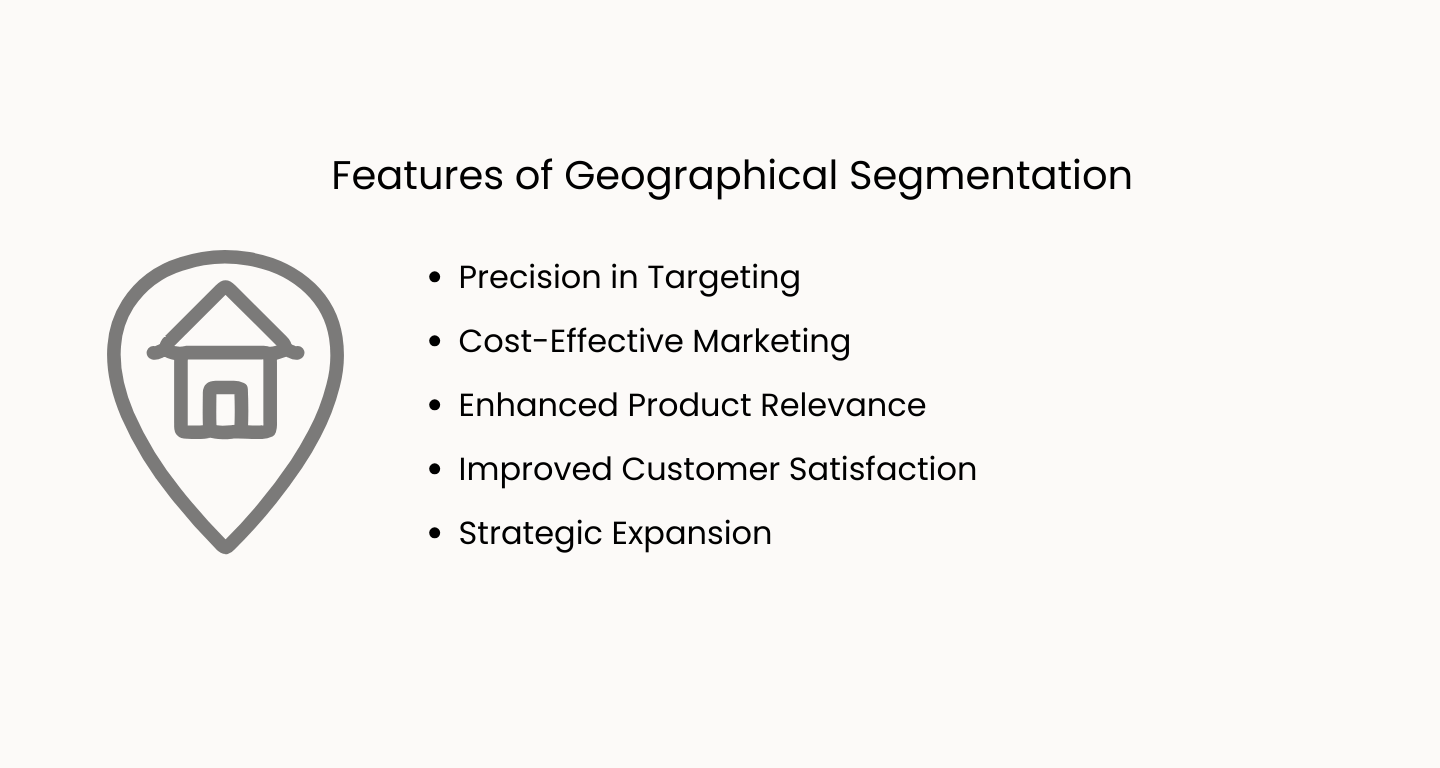Geographic segmentation involves dividing a market into distinct geographical units, such as countries, regions, or cities, to customize marketing strategies based on the specific needs and preferences of those locations. Imagine that your favorite local shop always has what you want, even before you ask. That’s the power of understanding where you are.
So, what exactly is geographical segmentation, and why does it matter?
What is Segmentation?
It is important to understand what segmentation is if you want to get a better hold of its nuances.
It is the process of dividing a larger market into smaller, identifiable groups of consumers who share similar characteristics, preferences, or behaviors. This division allows businesses to tailor their products, services, and marketing strategies to meet the specific needs of each segment, ultimately improving customer satisfaction and driving sales.
Confused?
To put it simply, segmentation means splitting a large group of customers into smaller, similar groups. It helps businesses understand their customers better and sell things that people want.
What is Geographic Segmentation?
So, what exactly is it? Geographic segmentation refers to the practice of dividing a market into smaller, specific geographic units such as countries, states, cities, or neighborhoods. This approach allows businesses to tailor their products, services, and marketing strategies according to the unique preferences and needs of different locations, ensuring more effective and relevant customer engagement.
Let’s take the example of a company that sells air conditioners.
Geographical segmentation for this business would involve understanding different regions’ climates. In hot and humid areas, like tropical countries, there’s a higher demand for powerful air conditioners. On the other hand, in cooler regions, the demand might be for energy-efficient heating solutions.
By recognizing these regional differences, the company can customize its product offerings and marketing messages. This targeted approach ensures that customers in every area get what they need, making the business more successful in diverse markets.
Features of Geographical Segmentation
Geographical segmentation is a powerful tool for businesses, allowing them to navigate diverse markets with precision and insight. Here are the key features that make geographical segmentation essential in the realm of marketing:

1. Precision in Targeting
It helps businesses identify specific demographics in different regions. By understanding the unique needs of these groups, companies can create highly targeted marketing campaigns. For instance, a company selling ski equipment would focus on regions with snowy climates, ensuring their efforts are concentrated where they matter the most.
2. Cost-Effective Marketing
By concentrating resources on regions with higher potential, businesses can optimize their marketing budget. Let’s admit it, a one-size-fits-all approach does not do the job anymore. Rather than that, they invest in areas where their products or services are in demand, ensuring a higher return on investment.
3. Enhanced Product Relevance
Geographic segmentation allows companies to adapt their offerings to local preferences. For instance, a food chain might localize its menu and include regional delicacies. This customization increases the relevance of products and enhances customer satisfaction and loyalty.
4. Improved Customer Satisfaction
When customers feel that a business understands their specific needs, they are more likely to be satisfied with their purchases. Geographical segmentation ensures that businesses offer products and services tailored to the cultural, economic, and social context of each region. This personalized approach enhances the customer experience and fosters long-term relationships.
5. Strategic Expansion
For businesses looking to expand into new markets, it provides valuable insights. By analyzing the demographics and preferences of different regions, companies can make decisions about where to establish their presence. This strategic expansion minimizes risks and maximizes growth opportunities.
How to Do Geographical Segmentation
By now, you might have understood that it is a nuanced process. It requires a deep understanding of diverse markets and tailoring strategies accordingly. But it isn’t that complex. Here’s an 8-step guide to make this easier for you:
#1 Get Digging with Market Research
Start by digging into data about different regions where you operate. Surveys, market reports, and online tools are your best friends here. Gather insights on what makes each region tick, from cultural quirks to spending habits.
#2 Spot the Standout Variables
Figure out the unique traits of each region. Is it cultural preferences, economic status, or perhaps climate-related needs? Pinpoint the variables that matter most for your product or service. These are your keys to unlocking specific market segments.
#3 Play Sherlock with Data Analysis
Now, put on your detective hat and analyze the data you’ve collected. Look for patterns and differences among regions. What do they have in common? Where do they diverge? This detective work helps you create distinct market segments for each region.
Read More: What is Market Segmentation: The Ultimate Guide
#4 Segmentation Magic Time
Slice and dice your market into these distinct segments. Each segment should represent a group of customers with similar needs or habits in a specific region. Think of it as putting together a puzzle—every piece (or segment) fits uniquely into the bigger picture.
#5 Cook Up Tailored Strategies
This is where the fun begins! Cook up marketing strategies that are as unique as each region. Use region-specific language, imagery, and cultural references in your ads. Tailor your promotions to match local holidays and traditions. The more localized, the better.
#6 Customize Your Offerings
Take a look at your products or services. Can they be tweaked to fit regional preferences better? Maybe it’s a different flavor, a localized feature, or even packaging that resonates with a specific area. Customization is the name of the game.
#7 Stay on Your Toes
Markets change; it’s a fact of life. Keep your finger on the pulse of each segment. Monitor sales, gather customer feedback, and stay updated on market trends. Be ready to adapt your strategies based on what your customers are saying and doing.
#8 Talk to Your Customers
Don’t forget the power of conversation. Engage with your customers in different regions. Ask for feedback, run polls, or simply have a chat on social media. Knowing what they love and what they want helps you refine your strategies and keep your customers happy.
While it is extremely beneficial, it is also important to streamline the lengthy process. You can use advanced tools such as SurveySparrow for data collection and analysis. The platform lets you create engaging surveys, collate data, analyze it, and act upon the insights gained. Yes, you heard it right—all this is possible on one platform!
14-Day Free Trial • No Credit Card Required • No Strings Attached
Importance of Geographic Segmentation
Here’s why understanding and implementing geographical segmentation is crucial:

1. Local Cultural Understanding
By geographically segmenting their customers, businesses can easily gain a deeper understanding of the local cultural differences and nuances of different regions.
It might seem like something that can be sidelined, but understanding local traditions, languages, and customs is essential! Why? To create marketing campaigns that resonate with the community. For instance, a company celebrating a regional festival in its advertisements can create an emotional connection with the local audience. This cultivates loyalty.
2. Smart Pricing Strategies
Different regions have diverse economic statuses, affecting consumers’ purchasing power. Geographical segmentation enables businesses to tailor their pricing strategies according to the economic conditions of specific areas. For instance, offering affordable or budget-friendly versions of products in economically challenged regions ensures accessibility, driving sales even in financially constrained markets.
3. Climate and Seasonal Adaptation
Climate significantly influences consumer behavior. Products and services that are suitable for one region’s climate might not be relevant in another.
Geographical segmentation allows businesses to adapt their offerings based on weather conditions. A beverage company might promote cold drinks in hot regions and warm beverages in colder climates, ensuring their products align with consumers’ needs throughout the year.
4. Competitive Advantage
It helps businesses gain a competitive edge. They can offer unique features or promotions that specifically appeal to a particular region. This individualized approach sets them apart from competitors, capturing the attention and loyalty of the local customer base.
5. Smart Business Investment
We know that resources, including marketing budgets and inventory, are finite. By investing in regions where demand is high and aligning resources with consumer preferences, businesses ensure optimal resource utilization. This maximizes profits while minimizing unnecessary expenditures.
Elements of Geographical Segmentation (Variables)
Geographical segmentation relies on several key variables to create targeted marketing strategies tailored to specific regions. These variables, or elements, serve as the foundation for understanding diverse markets. Here are the essential elements of geographical segmentation:
Cultural Factors
Cultural diversity greatly influences consumer behavior. Language, traditions, values, and lifestyles vary across regions, impacting purchasing decisions. Businesses need to grasp these cultural nuances to create culturally sensitive advertising and products that resonate with the local audience.
Economic Factors
Economic variables such as income levels, employment rates, and overall economic stability play a vital role in shaping consumer purchasing power. Understanding the economic dynamics of different regions helps businesses price their products appropriately, ensuring affordability and accessibility.
Climate and Geography
Climate significantly affects product demand. Products suitable for cold climates might not be relevant in warm regions. Similarly, geographical features like urban or rural settings influence consumer needs. Geographic segmentation considers these factors to adapt products and marketing strategies accordingly.
Social and Demographic Factors
Social aspects such as age, gender, family structure, and education levels impact consumer preferences. Demographic information provides insights into the composition of the population, enabling businesses to tailor their offerings to specific age groups, family sizes, or educational backgrounds.
Technological Factors
Access to technology, internet penetration, and digital literacy levels vary across regions. Technological factors influence online shopping habits, digital marketing effectiveness, and the adoption of innovative products. Geographical segmentation accounts for these variables in digital marketing strategies and product development.
Regulatory and Legal Considerations
Regulations and laws differ from one region to another. Geographical segmentation involves understanding legal constraints, certifications, and product standards specific to each area. Adhering to these regulations is crucial for successful market entry and product acceptance.
Examples of Geographic Segmentation
Here are real-world examples of companies effectively utilizing geographical segmentation:
1. Starbucks: Tailored Global Flavors
Starbucks uses geographical segmentation brilliantly!
In countries like India, where tea is a popular choice, Starbucks offers a unique “Chai Tea Latte,” appealing to the local taste. In contrast, in the United States, where coffee culture is prominent, the focus might be on seasonal beverages like the “Pumpkin Spice Latte.” By adapting their menu to regional preferences, Starbucks ensures that every customer finds something familiar and delightful.
2. IKEA: Furniture for Every Home
In smaller urban apartments in cities like Tokyo, where space optimization is crucial, IKEA offers multifunctional furniture pieces such as sofa beds and foldable tables. In contrast, in larger suburban homes in places like California, IKEA provides spacious furniture sets with a focus on comfort and aesthetics.
By tailoring their designs to match the varying lifestyles and living spaces worldwide, they ensure that customers in different regions find practical and stylish solutions for their homes.
How Marketers Use Geographic Segmentation
Let’s wrap this up by answering the most important question.
Marketers utilize geographic segmentation by tailoring marketing messages, products, and pricing to specific regions. They create localized campaigns, adjust product features to suit local needs, offer region-specific promotions, engage with audiences on social media, optimize distribution channels, and target online advertising based on geographic location. This targeted approach ensures that businesses connect with customers on a personal level, boosting sales and brand loyalty.
Moreover, streamlining the process is crucial to gaining a competitive edge. Give SurveySparrow a spin before you leave!
14-Day Free Trial • No Credit Card Required • No Strings Attached
14-Day Free Trial • No Credit Card Required • No Strings Attached






